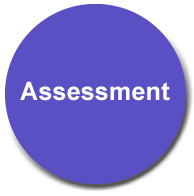The following components of the assessment program provide teachers with the tools to plan instruction and communicate student progress on the mathematical content in Grade 5.

x
Resources for Teachers
- Charles, R. “Big Ideas and Understandings as the Foundation for Elementary and Middle School Mathematics.” Journal of Mathematics Education Leadership, 7 (3), pp. 9–24, 2005.
- Dacey, L., and J.B. Lynch. Math for All: Differentiating Instruction Grades 3–5. Math Solutions Publications, CA, 2007.
- Guskey, T.R., and J.M. Bailey. Developing Grading and Reporting Systems for Student Learning. Corwin Press, Inc., CA, 2001.
- Jorgensen, M. “Assessing Habits of Mind: Performance-Based Assessment in Science and Mathematics.” Eric Clearinghouse for Science, Mathematics, and Environmental Education, Columbus, OH, 1994.
- Krulik, S., and J.A. Rudnick. Assessing Reasoning and Problem Solving: A Sourcebook for Elementary School Teachers. Allyn and Bacon, Pearson, NJ, 1998.
- Mathematics Assessment: A Practical Handbook for Grades 3–5. J.K. Stenmark and W.S. Bush, ed. National Council of Teachers of Mathematics, Reston, VA, 2001.
- Murray, M., with J. Jorgensen. The Differentiated Classroom: A Guide for Teachers, K–8. Heinemann, Portsmouth, NH, 2007.
- Pellegrino, J.W., and S.R. Goldman. “Beyond Rhetoric: Realities and Complexities of Integrating Assessment into Classroom Teaching and Learning.” In The Future of Assessment: Shaping Teaching and Learning. C. Dwyer ed. Erlbaum, Mahwah, NJ, 2007.
- Principles and Standards for School Mathematics. National Council of Teachers of Mathematics, Reston, VA, 2000.
- Tomlinson, C.A. How to Differentiate Instruction in Mixed-Ability Classrooms. 2nd Ed. Association for Supervision and Curriculum Development, Alexandria, VA, 2001.
- Van de Walle, J.A., and L. Lovin. Teaching Student-Centered Mathematics: Grades 3–5. Pearson Education, Boston, 2006.















 ) on the Unit 10 Key Assessment Opportunities Chart. See Figure 2. In this unit, students will also get better acquainted with the Math Practices Expectations by discussing them in the context of a specific problem, receiving feedback, reviewing a peer's work, and revising their own work.
) on the Unit 10 Key Assessment Opportunities Chart. See Figure 2. In this unit, students will also get better acquainted with the Math Practices Expectations by discussing them in the context of a specific problem, receiving feedback, reviewing a peer's work, and revising their own work.